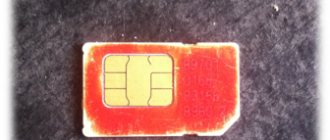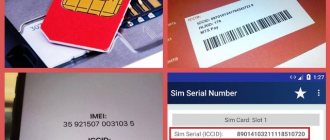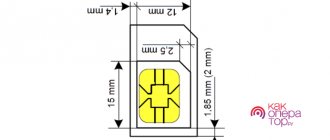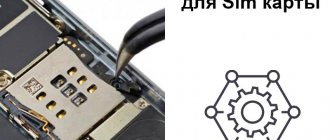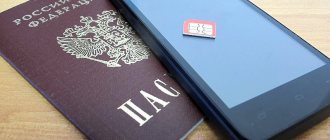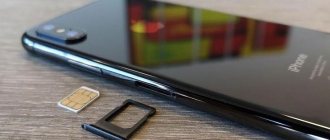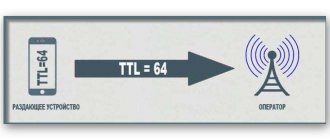Nano-SIM is a miniature version of a standard SIM card. The same SIM card, just in a smaller size. Previously it was longer and wider. Now the plastic edges have been removed. In 2021, nano SIM cards are used in many mobile devices.
You can see what a nano-SIM looks like in the photo:
The nano SIM card size is as follows.
- Length 12.3 mm,
- Width 8.8 mm.
Sizes vary depending on the campaign, but not much.
Peculiarities
There were no special innovations in the chip:
- The size has decreased.
- Excess plastic was removed to reduce weight.
- Essentially this is a copy of micro.
Types of SIM cards
Today there are only 3 types of SIM cards, these are:
- Mini-SIM
- Micro-SIM
- Nano-SIM
Mini - sim is an ordinary and familiar SIM card, standard size, which is usually called a “SIM card”, without the “mini” prefix. The most common format of SIM cards, but today they are increasingly difficult to find in new flagship smartphone models. The size of a regular, standard SIM card or mini-sim is 25 X 15mm
Micro - sim is the same SIM card as a mini-sim, but unlike it, a micro-sim has a smaller size of 15 X 12mm. As a rule, SIM cards are sold with the ability to turn a regular SIM card into a micro-SIM card by simply squeezing a micro-SIM out of the card’s plastic frame.
A universal or multi-SIM card looks like this (you can see the boundaries along which you need to squeeze out the required SIM card size):
eSIM in the smartphones of the future
Traditional and familiar SIM card slots will replace virtual cards in the coming years, and information about network data will be available after entering information from the operator. This approach has already been implemented in the Samsung Gear S2 (Classic 3G) smartwatch.
The introduction of eSIM will not only save case space, but will also facilitate the transition from one operator to another. Together with the built-in information about the operator, the maximum Internet access speed will increase. It is predicted that gadget manufacturers may take over the regulation of tariffs for using operator services, so there is a possibility that mobile communications will become more accessible.
( 10 ratings, average: 4.30 out of 5)
What is a Nano SIM card?
Nano - sim is the newest SIM card format, and today it is the smallest SIM card size for smartphones and tablets. The Nano SIM does not have any plastic around the chip like you see on the Mini SIM and Micro SIM. The size of a nano SIM card is half the size of a standard SIM card and is 12.3 X 8.8 millimeters, which is practically the size of the chip itself, but still has a small border.
Micro-SIM
Apple, as a trendsetter in the mobile world, in 2003 first introduced a smartphone that supports a Micro SIM card. Its dimensions are 15 x 12 mm . Most gadget manufacturers supported the idea, and over the next few years this format became the standard. Along with this size of SIM cards, 4G Internet became available.
Micro-SIM and nano-SIM: the difference is in the size of the plastic or in the chip?
Based on the above characteristics of SIM cards, you can notice a significant reduction in plastic, directly along the edges of the SIM card chip. The dimensions of SIM cards are the key and main feature of what the SIM card is called. This size only affects the plastic; there are no and cannot be any changes in the chip itself. You can use a regular SIM card (mini-SIM), and if you update your smartphone to a newer model that requires a micro-SIM, you can change it to the desired size at any time, be it micro-SIM or nano-SIM.
SIM cards - functions and features
Once upon a time, more than 20 years ago, which by the standards of the modern IT industry can even be considered untrue, mobile phones used special numbers recorded in them at the factory to identify themselves in the cellular provider network. However, this approach was not very convenient for both users and manufacturers. They were interested in "separating" the subscriber ID from the hardware. This is how the idea of using additional individual cards with built-in microcircuits arose. This approach is used today in networks of various standards - GSM, CDMA, UMTS, LTE, but we will talk mainly about the most widespread option - GSM/3G.
The telephone device, as a physical device, has an IMEI (International Mobile Equipment Identity) number, which can be considered unique on a global scale. It participates in the transaction logs of the cellular operator and, in principle, can be used to block access to the network, search for stolen phones and other similar actions. In some countries, it is illegal to falsify or change this number. The IMEI number can usually be found on a sticker under the battery and on the box. From a technical point of view, it is written electronically in one of the microcircuits and, of course, can also be read programmatically. If the telephone has the ability to install several SIM cards, then there are also several IMEI numbers. This number is available not only for phones, but also for modems, tablets and other devices designed to work in mobile networks. Formally, manufacturers could get by with just this number and not use traditional serial numbers for their products, but today this “separate” approach is more convenient for them.
A similar SIM card number is called ICCID (Integrated Circuit Card Identifier). It is often engraved on the cards themselves. It is similar to the serial number of the device - the only difference is that it is unique and cannot be repeated on any other card in the world. Although if you add the manufacturer and model name to the serial number of the phone, then this combination will also be unique.
Direct identification of the subscriber in the cellular network takes place using the IMSI (International Mobile Subscriber Identity) number, which is recorded in the SIM card. This number determines the ownership of the card by the operator and allows you to link the card user with his account with the provider, including the phone number, permitted services, and so on. The card also stores other unique information, the description of which is beyond the scope of this article.
A few words should be said about card protection. The first milestone is a four-digit PIN code. If you don't know it, you won't be able to use the card to access a cellular network or read your address book. The user can change or cancel this code (it is usually disabled on newly purchased cards). If the PIN code was entered incorrectly several times, to unlock it you need to use the PUK code, also provided by the operator along with the SIM card. Even less commonly used are PIN2 and PUK2 codes, which allow the user to limit the list of allowed subscribers for outgoing calls.
But even if you know all these codes, you won’t be able to copy the card using everyday methods. There is another special code written inside it, known to the operator, which is used in the identification algorithm. This process is designed in such a way that the pure code is not transferred from the card to the phone. Instead, the device sends a task to the SIM card processor to encrypt the key, and transmits the response to the operator. The latter compares the result with that received in its data center, and if they match, the subscriber gains access to the network.
One of the popular options for “full-size” smart cards today
Technically, a SIM card is one of the variants of smart cards - microcomputers with their own processor and memory that communicate with the outside world through an interface of several electrical contacts. Smart cards are found today in the banking industry, used for access control and in various payment systems. Usually the card has several kilobytes of permanent memory, a couple of kilobytes of RAM and some flash. In the case of phones, the latter was previously used to store a notebook, but the limit on the number of entries (250) and support for only two fields (name and phone) has practically deprived it of this role today.
Electronic filling takes up very little space
Formally, the card has eight contacts for connecting to a reader (if you try really hard, you can try to count more). However, in reality only six are used. And given modern progress in microelectronics, the filling takes up literally a few square millimeters.
But if we talk about external dimensions, then it all started with a credit card format - 85.6 × 53.98 × 0.76 mm. This format of smart cards is still used today, but it stopped satisfying the wishes of cell phone manufacturers a very long time ago. Much more practical is the Mini-SIM version, which measures 25x15 mm with a beveled corner (to determine the required orientation of the card in the slot). The thickness did not change. It is this format that is the most widespread today and is found in most cell phones.
Mini-SIM and Micro-SIM cards use much less plastic
It is clear that such a reduction did not bring any losses in terms of functionality. But you need to understand that Mini-SIM is good specifically for placement in a telephone body. Using a card of this size, for example, for payphones, is obviously inconvenient.
After the massive transition to the Mini-SIM format, for a very long time it remained practically the only option for use in the field of mobile communications. Even successes in reducing the external dimensions of telephone sets did not require further reduction of the subscriber card. But still, he was not allowed to gain a foothold for centuries.
Special frames can be used to install Micro-SIM (sometimes Mini-SIM)
One of the most active market players in its new smartphone model two and a half years ago implemented work with the Micro-SIM format, the dimensions of the cards are 15x12 mm (the thickness has not changed again). For cards of this format, almost the entire front surface was occupied by contact pads. But there were no technical difficulties for him to place the chip, especially with the development of chip manufacturing technologies. Note that, from a consumer device design perspective, the market did not require this step. So, rather, the company played in the field of marketing, once again repeating “we are not like everyone else.”
Electronic “filling” takes up very little space even in Mini- and Micro-SIM
Interestingly, this year the same manufacturer played this card again. The latest model of their smartphone works exclusively with Nano-SIM, in which the thickness has already been reduced - 12.3 × 8.8 × 0.67 mm. Eight standard contacts no longer fit into this format, so only six truly working ones remain. No technical functions of the card were affected this time either, but the size of the new phone was not as reduced as one might think (and some even increased).
Almost the entire front surface of Nano-SIM is occupied by contact pads
A very reasonable question arises: how does this miniaturization story affect consumers? If we talk about those who buy a new phone with a contract and a new card, they usually don’t care what version of the SIM card is installed in it. And if a person basically has only one phone or he doesn’t plan to rearrange cards, then it’s not even “usually”, but “absolutely”.
To install Micro-SIM in the Mini-SIM bay, you can use adapters
But for those users who are accustomed to using several devices and/or SIM cards, the situation is less pleasant. In the case of a Mini/Micro pair, you can try to make do with so-called adapters/adapters (of course, after replacing all Mini format cards with Micro format cards). There are no advantages to this story, only disadvantages - you need to carry additional parts with you, and in addition, the adapter can damage the connector contacts during replacement (or the assembly may even get stuck in the slot).
As for changing cards, the official way is to visit your operator’s salon, write an application, wait and all that. In addition, if you suddenly have some entries on the card, you will need to take care of saving them. A more affordable option in terms of time spent is to contact numerous workshops, where your card will be cut with a special tool in a couple of seconds (by the way, large salons and even the operators themselves do this). If you really don’t want to go anywhere, then a sharp knife and a strong hand can also successfully solve the problem. For the first time, a printout from the Internet with a “cutting” diagram may be useful (see, for example, option 1, option 2).
With Nano-SIM the situation is more complicated, since both the linear dimensions and thickness of the card are smaller. The methods remain the same. But at present the first of them should be recognized as the most correct. However, given the prevalence and cost of the device, for which you may need a Nano-SIM, this should not be a problem.
